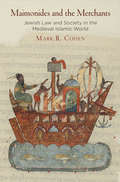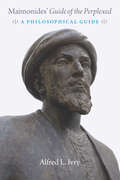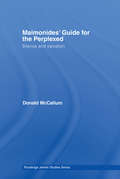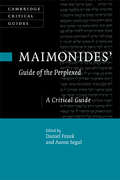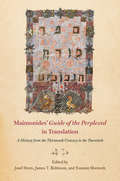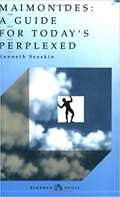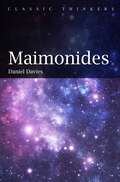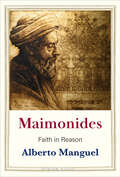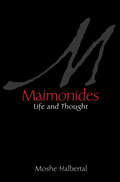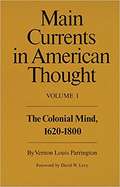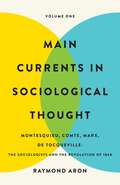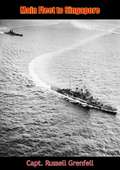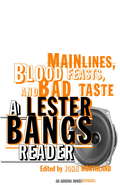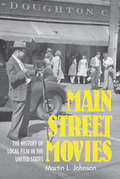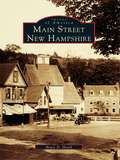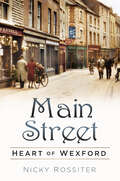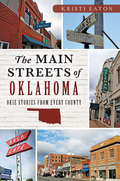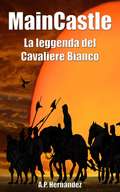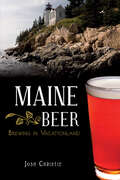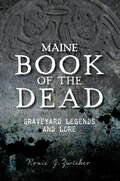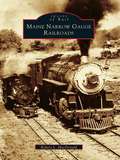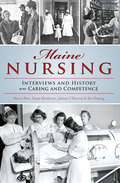- Table View
- List View
Maimonides and the Merchants: Jewish Law and Society in the Medieval Islamic World (Jewish Culture and Contexts)
by Mark R. CohenThe advent of Islam in the seventh century brought profound economic changes to the Jews living in the Middle East, and Talmudic law, compiled in and for an agrarian society, was ill equipped to address an increasingly mercantile world. In response, and over the course of the seventh through eleventh centuries, the heads of the Jewish yeshivot of Iraq sought precedence in custom to adapt Jewish law to the new economic and social reality.In Maimonides and the Merchants, Mark R. Cohen reveals the extent of even further pragmatic revisions to the halakha, or body of Jewish law, introduced by Moses Maimonides in his Mishneh Torah, the comprehensive legal code he compiled in the late twelfth century. While Maimonides insisted that he was merely restating already established legal practice, Cohen uncovers the extensive reformulations that further inscribed commerce into Jewish law. Maimonides revised Talmudic partnership regulations, created a judicial method to enable Jewish courts to enforce forms of commercial agency unknown in the Talmud, and even modified the halakha to accommodate the new use of paper for writing business contracts. Over and again, Cohen demonstrates, the language of Talmudic rulings was altered to provide Jewish merchants arranging commercial collaborations or litigating disputes with alternatives to Islamic law and the Islamic judicial system.Thanks to the business letters, legal documents, and accounts found in the manuscript stockpile known as the Cairo Geniza, we are able to reconstruct in fine detail Jewish involvement in the marketplace practices that contemporaries called "the custom of the merchants." In Maimonides and the Merchants, Cohen has written a stunning reappraisal of how these same customs inflected Jewish law as it had been passed down through the centuries.
Maimonides' "Guide of the Perplexed": A Philosophical Guide
by Alfred L. IvryA classic of medieval Jewish philosophy, Maimonides's Guide of the Perplexed is as influential as it is difficult and demanding. Not only does the work contain contrary--even contradictory--statements, but Maimonides deliberately wrote in a guarded and dissembling manner in order to convey different meanings to different readers, with the knowledge that many would resist his bold reformulations of God and his relation to mankind. As a result, for all the acclaim the Guide has received, comprehension of it has been unattainable to all but a few in every generation. Drawing on a lifetime of study, Alfred L. Ivry has written the definitive guide to the Guide--one that makes it comprehensible and exciting to even those relatively unacquainted with Maimonides' thought, while also offering an original and provocative interpretation that will command the interest of scholars. Ivry offers a chapter-by-chapter exposition of the widely accepted Shlomo Pines translation of the text along with a clear paraphrase that clarifies the key terms and concepts. Corresponding analyses take readers more deeply into the text, exploring the philosophical issues it raises, many dealing with metaphysics in both its ontological and epistemic aspects.
Maimonides' Guide for the Perplexed: Silence and Salvation (Routledge Jewish Studies Series)
by Donald McCallumProviding an excellent overview of the latest thinking in Maimonides studies, this book uses a novel philosophical approach to examine whether Maimonides' Guide for the Perplexed contains a naturalistic doctrine of salvation after death. The author examines the apparent tensions and contradictions in the Guide and explains them in terms of a modern philosophical interpretation rather than as evidence of some esoteric meaning hidden in the text.
Maimonides' Guide of the Perplexed: A Critical Guide (Cambridge Critical Guides)
by Daniel Frank Aaron SegalMoses Maimonides' Guide of the Perplexed (c. 1190) is the greatest and most influential text in the history of Jewish philosophy. Controversial in its day, the Guide directly influenced Aquinas, Spinoza, and Leibniz, and the history of Jewish philosophy took a decisive turn after its appearance. While there continues to be keen interest in Maimonides and his philosophy, this is the first scholarly collection in English devoted specifically to the Guide. It includes contributions from an international team of scholars addressing the most important philosophical themes that range over the three parts of this sprawling work - including topics in the philosophy of language, metaphysics, epistemology, philosophy of law, ethics, and political philosophy. There are also essays on the Guide's hermeneutic puzzles, and on its overall structure and philosophical trajectory. The volume will be of interest to philosophers, Judaists, theologians, and medievalists.
Maimonides' "Guide of the Perplexed" in Translation: A History from the Thirteenth Century to the Twentieth
by Josef Stern James T. Robinson Yonatan ShemeshMoses Maimonides’s Guide of the Perplexed is the greatest philosophical text in the history of Jewish thought and a major work of the Middle Ages. For almost all of its history, however, the Guide has been read and commented upon in translation—in Hebrew, Latin, Spanish, French, English, and other modern languages—rather than in its original Judeo-Arabic. This volume is the first to tell the story of the translations and translators of Maimonides’ Guide and its impact in translation on philosophy from the Middle Ages to the present day. A collection of essays by scholars from a range of disciplines, the book unfolds in two parts. The first traces the history of the translations of the Guide, from medieval to modern renditions. The second surveys its influence in translation on Latin scholastic, early modern, and contemporary Anglo-American philosophy, as well as its impact in translation on current scholarship. Interdisciplinary in approach, this book will be essential reading for philosophers, historians, and religious studies scholars alike.
Maimonides: Critical Essays (Classic Thinkers)
by Daniel DaviesThe most famous of all medieval Jewish thinkers, Moses Maimonides is known for his monumental contributions to Jewish law, theology and medicine, and for an influence that extends into the wider world. His remarkable work, The Guide for the Perplexed, is notoriously difficult to interpret, since Maimonides aimed it at those already versed in both philosophy and the rabbinic tradition and used literary techniques to test his readers and force them to think through his arguments. Daniel Davies explores Maimonides’ approaches to issues of perennial and universal concern: human nature and the soul, the problem of evil, the creation of the world, the question of God’s existence, and negative theology. He addresses the unusual ways in which Maimonides presented his arguments, contextualising Maimonides’ thought in the philosophy and religion of his own time, as well as elucidating it for today’s readers. This philosophically rich introduction is an essential guide for students and scholars of medieval philosophy, philosophy of religion, theology and Jewish studies.
Maimonides: Faith in Reason (Jewish Lives)
by Alberto ManguelAn exploration of Maimonides, the medieval philosopher, physician, and religious thinker, author of The Guide of the Perplexed, from one of the world&’s foremost bibliophiles Moses ben Maimon, or Maimonides (1138–1204), was born in Córdoba, Spain. The gifted son of a judge and mathematician, Maimonides fled Córdoba with his family when he was thirteen due to Almohad persecution of all non-Islamic faiths. Forced into a long exile, the family spent a decade in Spain before settling in Morocco. From there, Maimonides traveled to Palestine and Egypt, where he died at Saladin&’s court. As a scholar of Jewish law, a physician, and a philosopher, Maimonides was a singular figure. His work in extracting all the commanding precepts of Jewish law from the Hebrew Bible and the Talmud, interpreting and commenting on them, and translating them into terms that would allow students to lead sound Jewish lives became the model for translating God&’s word into a language comprehensible by all. His work in medicine—which brought him such fame that he became Saladin&’s personal physician—was driven almost entirely by reason and observation. In this biography, Alberto Manguel examines the question of Maimonides&’ universal appeal—he was celebrated by Jews, Arabs, and Christians alike. In our time, when the need for rationality and recognition of the truth is more vital than ever, Maimonides can help us find strategies to survive with dignity in an uncertain world.
Maimonides: Life and Thought
by Moshe HalbertalA comprehensive and accessible account of the life and thought of Judaism's most celebrated philosopherMaimonides was the greatest Jewish philosopher and legal scholar of the medieval period, a towering figure who has had a profound and lasting influence on Jewish law, philosophy, and religious consciousness. This book provides a comprehensive and accessible introduction to his life and work, revealing how his philosophical sensibility and outlook informed his interpretation of Jewish tradition.Moshe Halbertal vividly describes Maimonides's childhood in Muslim Spain, his family's flight to North Africa to escape persecution, and their eventual resettling in Egypt. He draws on Maimonides's letters and the testimonies of his contemporaries, both Muslims and Jews, to offer new insights into his personality and the circumstances that shaped his thinking. Halbertal then turns to Maimonides's legal and philosophical work, analyzing his three great books—Commentary on the Mishnah, the Mishneh Torah, and the Guide of the Perplexed. He discusses Maimonides's battle against all attempts to personify God, his conviction that God's presence in the world is mediated through the natural order rather than through miracles, and his locating of philosophy and science at the summit of the religious life of Torah. Halbertal examines Maimonides's philosophical positions on fundamental questions such as the nature and limits of religious language, creation and nature, prophecy, providence, the problem of evil, and the meaning of the commandments.A stunning achievement, Maimonides offers an unparalleled look at the life and thought of this important Jewish philosopher, scholar, and theologian.
Main Currents in American Thought: Volume1--The Colonial Mind (1620-1800)
by Vernon Louis ParringtonAnalysis of how our scholarship developed. <P><P> Pulitzer Prize Winner
Main Currents in Sociological Thought: Durkheim, Pareto, Weber
by Raymond AronThe second volume of the landmark study, examining the work of sociology&’s defining thinkers from the turn of the nineteenth century to the interwar periodMain Currents in Sociological Thought remains a foundational synthesis in the field. In this second and final volume of his classic survey, Raymond Aron explores the work of three figures who profoundly shaped sociology as it entered the twentieth century: Durkheim, who continued Comte&’s quest for a science of society and a scientific validation of morality; Pareto, the Italian &“neo-Machiavellian&” who emphasized the elitist character of all societies; and Weber, the German sociologist who reflected critically on the prospects for human freedom in an age of disenchantment. Bringing together penetrating intellectual portraits of these great thinkers and close readings of their most consequential texts, Main Currents in Sociological Thought highlights the historical and intellectual context within which each man wrote and draws out their works&’ enduring insights and influence in the field today.
Main Currents in Sociological Thought: Montesquieu, Comte, Marx, De Tocqueville: The Sociologists and the Revolution of 1848
by Raymond AronThe first volume of the landmark study, tracing the emergence and formation of sociological thought from the French liberal school to the Marxists Main Currents in Sociological Thought remains a foundational synthesis in the field. In this first part of his magisterial two-volume survey, Raymond Aron embraces an expansive definition of sociology that merges empirical inquiry with historical and social analysis. At its core, Aron&’s work is an engagement with the very question of modernity: How did the intellectual currents that emerged in the eighteenth century shape the modern political and philosophical order? With scrupulous fairness, Aron examines the thoughts and arguments of the discipline&’s major social thinkers to discern how they answered this question. Volume 1 explores three traditions: the French liberal school of political sociology, represented by Montesquieu and Tocqueville; the Comtean tradition, anticipating Durkheim in its elevation of social unity and consensus; and the Marxists, who posited the struggle between classes and placed their faith in historical necessity. Written with his customary lucid elegance of thought and style, Aron&’s work is essential reading for students across the social sciences.
Main Fleet to Singapore [Illustrated Edition]
by Capt. Russell GrenfellIncludes 14 illustrations and 6 maps.A fascinating in-depth account of the early months of the naval war against the Japanese during the Second World War. Includes the sinking of the Royal Navy battleship Prince of Wales and battle cruiser Repulse off Malaya in December 1941 and the American victory at Midway in June 1942.“A sharply written, often polemical, account of the Singapore naval base from its inception to its loss in 1942”—Foreign Affairs
Main Lines, Blood Feasts, and Bad Taste
by John Morthland Lester BangsBefore his untimely death in 1982, Lester Bangs was inarguably the most influential critic of rock and roll. Writing in hyper-intelligent Benzedrine prose that calls to mind Jack Kerouac and Hunter S. Thompson, he eschewed all conventional thinking as he discussed everything from Black Sabbath being the first truly Catholic band to Anne Murray's smoldering sexuality. In Mainlines, Blood Feasts, Bad Taste fellow rock critic John Morthland has compiled a companion volume to Psychotic Reactions and Carburetor Dung, the first, now classic collection of Bangs's work. Here are excerpts from an autobiographical piece Bangs wrote as a teenager, travel essays, and, of course, the music pieces, essays, and criticism covering everything from titans like Miles Davis, Lou Reed, and the Rolling Stones to esoteric musicians like Brian Eno and Captain Beefheart. Singularly entertaining, this book is an absolute must for anyone interested in the history of rock.From the Trade Paperback edition.
Main Lines, Blood Feasts, and Bad Taste: A Lester Bangs Reader
by John MorthlandBefore his untimely death in 1982, Lester Bangs was arguably the most influential critic of rock and roll. Writing in hyper-intelligent Benzedrine prose that calls to mind Jack Kerouac and Hunter S. Thompson, he eschewed all conventional thinking as he discussed everything from Black Sabbath being the first truly Catholic band to Anne Murray's smoldering sexuality. In Mainlines, Blood Feasts, Bad Taste fellow rock critic John Morthland has compiled a companion volume to Psychotic Reactions and Carburetor Dung, the first, now classic collection of Bangs's work. Here are excerpts from an autobiographical piece Bangs wrote as a teenager, travel essays, and, of course, the music pieces, essays, and criticism covering everything from titans like Miles Davis, Lou Reed, and the Rolling Stones to esoteric musicians like Brian Eno and Captain Beefheart. Singularly entertaining, this book is an absolute must for anyone interested in the history of rock.
Main Street Movies: The History of Local Film in the United States
by Martin L. Johnson"See yourself in the movies!"Prior to the advent of the home movie camera and the ubiquitousness of the camera phone, there was the local film. This cultural phenomenon, produced across the country from the 1890s to the 1950s, gave ordinary people a chance to be on the silver screen without leaving their hometowns. Through these movies, residents could see themselves in the same theaters where they saw major Hollywood motion pictures. Traveling filmmakers plied their trade in small towns and cities, where these films were received by locals as being part of the larger cinema experience. With access to the rare film clips under discussion, Main Street Movies documents the diversity and longevity of local film production and examines how itinerant filmmakers responded to industry changes to keep sponsors and audiences satisfied. From town pride films in the 1910s to Hollywood knockoffs in the 1930s, local films captured not just images of local people and places but also ideas about the function and meaning of cinema that continue to resonate today.
Main Street, New Hampshire
by Bruce D. HealdThe roots of many cherished American traditions may be found on the main streets of New Hampshire towns. Often the heart of a town's social, political, and economic life, main streets offer a sense of identity, dignity, and serenity. Through images, Main Street New Hampshire reflects the romance and nostalgia of the past and showcases the sights and memorials of several important New Hampshire places, including Concord, Keene, Nashua, Rochester, Laconia, Exeter, Newmarket, and others. These images, many dating from as early as 1860, reflect the activity, architecture, transportation, and recreation at the heart of each community.
Main Street: Heart of Wexford
by Nicky RossiterWexford is one of the few towns or cities in Ireland where Main Street is still the main retail and commercial street of the town. In Dublin this honour goes to O’Connell and Grafton Street; in Cork it is Patrick Street; but in Wexford, Main Street is the hub and the site of Wexford’s hidden historical gems. Main Street: Heart of Wexford contains little-known photographs, interesting advertisements and intriguing information about the street, such as the presence of a bag factory on South Main Street, Frank Hall of Radio Telefis Eireann being the official opener of the Book Centre in Wexford on 13 June 1975, and that Lamb House was a shop at the top of Anne Street on the south side and had a life-size lamb as its shop sign. Both insightful and comprehensive, this book is a wonderful history concentrating on the principal street of Wexford.
Main Streets of Oklahoma, The: Okie Stories from Every County
by Kristi EatonIt's the heart of every community in the Sooner State. It's where people go to eat, shop and socialize. It's where Woods County reenacts the Freedom Bank Robbery and Shootout and where Grant County displays "Twister" memorabilia. Oklahoma residents are embracing Main Street, celebrating and revitalizing local history. Author Kristi Eaton crisscrosses the state, exploring each of the seventy-seven counties to find quirky stories like Elmore City's ties to "Footloose" and hidden tales like the real reason Wetumka celebrates Sucker Day. It's a celebration of the unique events, landmarks, people and heritage of this aptly named thoroughfare.
MainCastle. The Legend of the White Knight
by A. P. HernándezMainCastle, year 1319. "A dense layer of clouds threatens to hide the moon that illuminates the city with scarlet hues. The houses sleep in silence. Of all the houses, there is only one whose interior is still illuminated. One that resists falling into sleep, who remains awake despite the late night..." From the top of his castle, Count Joseph wields his unlimited power. Who will put an end to this nightmare? A novel with high doses of ACTION set in the LOW MIDDLE AGE.
MainCastle: La leggenda del Cavaliere Bianco
by A. P. HernándezUn romanzo d'azione ambientato nel Basso Medioevo. MainCastle, anno del Signore 1319. "Una densa cappa di nuvoloni minaccia di nascondere la luna, che illumina la città di toni scarlatti. Le case dormono silenziose. Di tutte le abitazioni, ce n’è solamente una il cui interno è ancora illuminato. Una che oppone resistenza al sonno, che rimane sveglia nonostante la profondità della notte..." Dal punto più alto del suo castello il Conte Joseph esercita il suo potere illimitato. Chi porrà fine a questo incubo?
Maine Beer: Brewing in Vacationland (American Palate)
by Josh Christie&“Chronicles Maine&’s rather complicated relationship with alcohol over the years, and offers histories and profiles of more than 30 brewing companies.&” —The Ellsworth American In the nineteenth and twentieth centuries, Maine was a stronghold for the temperance movement, but the Pine Tree State emerged from Prohibition to create a beer culture that rivals any other in the United States. Early pioneers, like D. L. Geary, established the Northeast&’s love affair with English-style ales, and today&’s upstarts brew unique and inventive recipes. Maine brewers create beer for every palate, and Maine&’s unique flavors—like blueberries, potatoes and even oysters—are frequently featured. Maine beer expert Josh Christie discovers the story of brewing in Vacationland by exploring Maine&’s large breweries, like Shipyard; its local crafters, like Rising Tide; the budding cider, spirits and mead industries; and, of course, the best places to drink across the state. &“The book explores the history of beer and beer brewing in Maine, starting with the formation of the state and continuing to the present day.&” —Shelf Awareness
Maine Book of the Dead: Graveyard Legends and Lore (American Legends)
by Roxie J. ZwickerMaine's graveyards contain the ancient memories and last words of woodsmen, lighthouse keepers, inventors, sea captains and the people who called this rugged land home. In an island cemetery rests Tall Barney, a six-foot-seven folk hero who single-handedly took down fifteen men in a Portland bar. Kittery holds the grave for the crew of the doomed ship the Hattie Eaton. Mount Hope Cemetery in Bangor is the final resting place for the famed "Sky Blue Madam" Fanny Jones and Public Enemy No. 1, gangster Al Brady. Camp Etna contains the grave of famed medium Mary Vanderbilt. Dead Man's Gulch in Wales holds many eerie tales of ghosts that refuse to leave. Join renowned author and tour guide Roxie Zwicker as she explores Maine's historic and legendary graveyards.
Maine Narrow Gauge Railroads
by Robert L. MacdonaldThe narrow gauge railroad arrived in the United States in the late nineteenth century. Based on the Welsh two-foot gauge, the American narrow gauge was expanded by railroad engineers to a three-foot gauge that became the standard track width for narrow gauge railroads in the United States. Maine, however, adopted the two-foot gauge that was developed by George E. Mansfield in Massachusetts. The narrow track width was ideally suited to the mountainous terrain, and the maneuverability of the trains proved highly beneficial to companies and passengers traveling to remote locations. The narrow gauge railroad served Maine for over fifty years until the early 1940s.Maine Narrow Gauge Railroads is a comprehensive pictorial record of the history of the narrow gauge railroad in Maine. From the one-hundred-twelve-mile Sandy River and Rangeley Lakes Railroad to the five-mile Kennebec Central, Maine Narrow Gauge Railroads features the toylike miniature trains of Maine as they appeared at different stages in their history. The Bridgton and Harrison Railroad, the Monson Railroad, and the Wiscasset, Waterville and Farmington Railway lines are documented within, as well as the current restoration projects that are under way.
Maine Nursing: Interviews and History on Caring and Competence
by Susan Henderson Valerie Hart Juliana L'Heureux Ann SossongMaine nurses have served tirelessly as caregivers and partners in healing at home and abroad, from hospitals to battlefields. The Division of Public Health Nursing and Child Hygiene was established in 1920 to combat high rates of infant mortality in Washington and Aroostook Counties. During the Vietnam War, Maine nurses helped build the Twelfth Evacuation Hospital at Cu Chi and bravely assisted surgeries in the midst of fighting. In the early 1980s, nurse disease prevention educators in Portland rose to the challenge of combating the growing AIDS epidemic. Through historical anecdotes and fascinating oral histories, discover the remarkable sacrifices and achievements of Maine's nurses.
